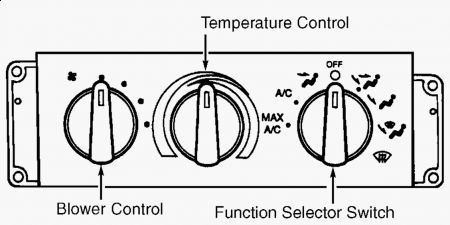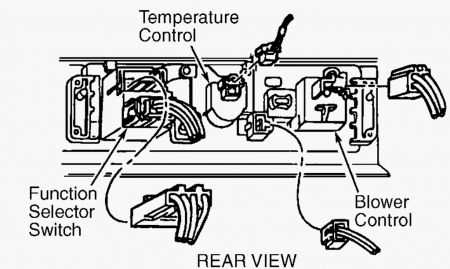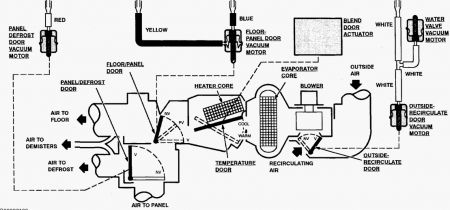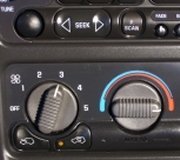OPERATION SYSTEM CONTROLS Function Selector Knob The function selector actuates an 8-port A/C vacuum control switch which controls vacuum control motors at floor, defrost/panel, defrost and outside/recirculation air doors. The function selector also controls on-off operation of the heater blower motor switch and activates the circuit for the A/C clutch circuit in the A/C position. In following modes, compressor operation is dependent on the A/C cycling switch: A/C (MAX or NORM), FLOOR/DEFROST and DEFROST. See Fig. 1 . Cut-out pressure is about 23 psi (1.6 kg/cm 2 ). Cut-in pressure is about 46 psi (3.2 kg/cm 2 ). Temperature Selector Knob The temperature selector actuates a variable resistance switch. This switch varies voltage to an electric actuator used to position temperature blend door. Positioning temperature selector in any position between full cold setting and full hot setting causes the temperature blend door to direct more or less outside air through or around heater core for whatever proportion of heated or unheated outside air is desired. See Fig. 1 . The air blends together as it leaves the heater core and enters the heater air plenum chamber for distribution. Vacuum Hoses An A/C plenum vacuum harness, which is attached to manual A/C control, directs vacuum to the different airflow doors within the heater air plenum chamber. Blower Control & A/C On-Off Switch The rotary blower control switch on control assembly controls blower motor speed (low, medium-low, medium-high and high). With function control knob in OFF position, blower motor will not operate. Thermal Limiter The blower motor switch resistor contains a thermal limiter. The thermal limiter serves as a temperature sensitive fuse. If resistor circuit opens due to excessive heat, replace resistor. Powertrain Control Module (PCM) The PCM monitors and regulates A/C system. EEC system, working through Wide Open Throttle (WOT) relay, disengages A/C clutch under the following conditions: immediately after start-up, wide open throttle, coolant temperature approaching overheating condition and engine idle RPM approaching stall speed. The PCM also regulates idle speed to compensate for A/C load and delays A/C engagement until RPM has been raised.




Saturday, April 11th, 2009 AT 8:03 AM






